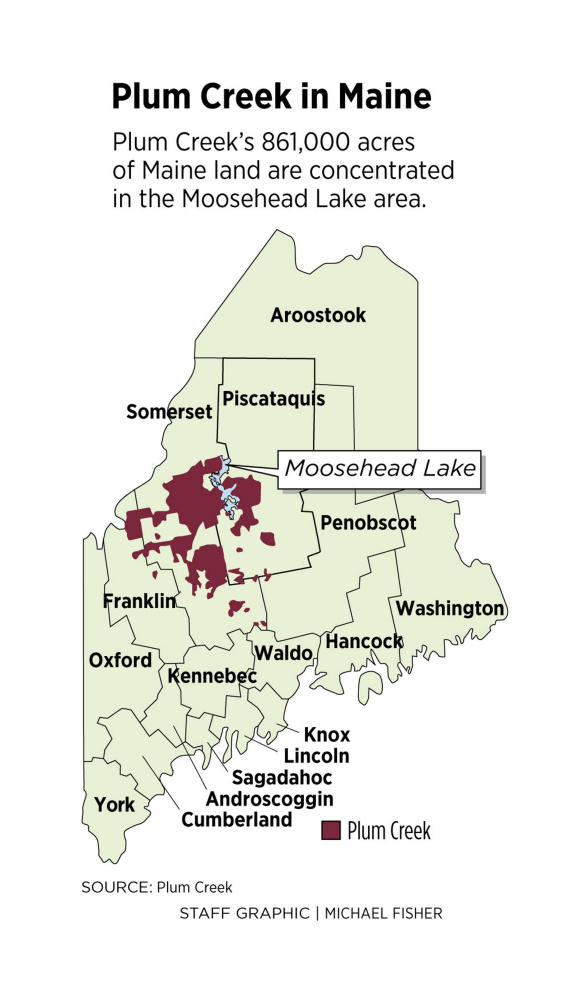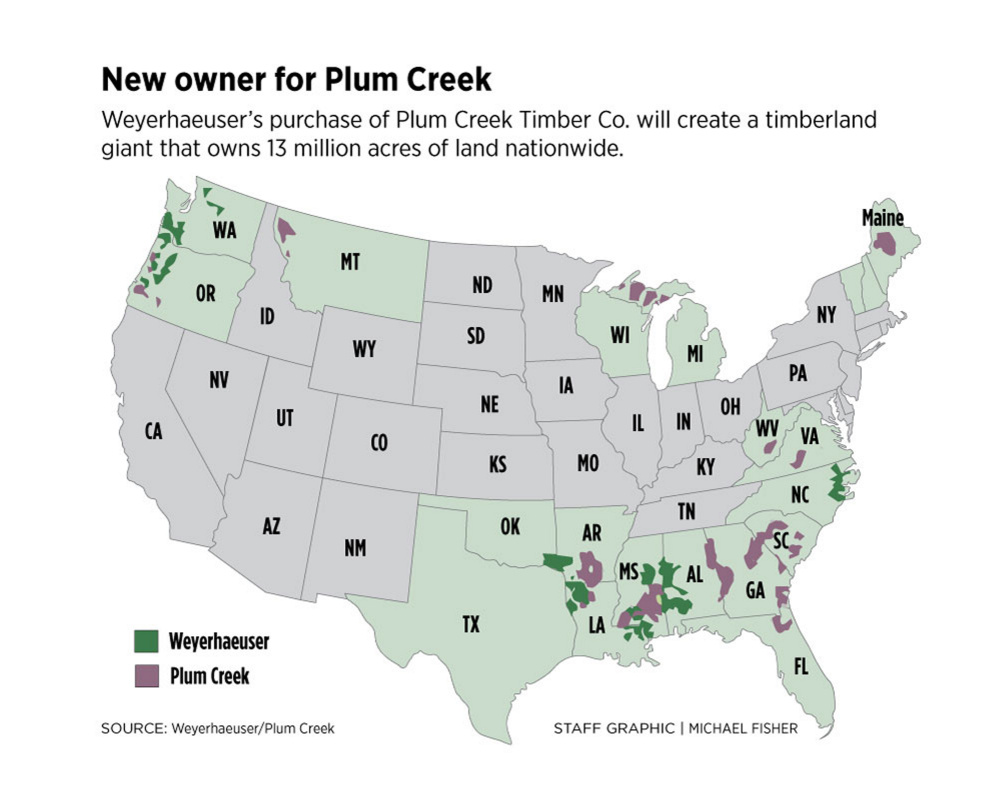A Plum Creek Timber Co. official said it will be “business as usual” in Maine as the company moves forward with a plan to merge with Weyerhaeuser Co., forming one of the world’s largest timberland businesses.
Weyerhaeuser plans to buy Seattle-based Plum Creek for $8.4 billion in a deal that would give Weyerhaeuser control of an estimated 13 million acres nationwide and create a company valued at $23 billion. Although Weyerhaeuser and Plum Creek currently operate in some of the same regions of the southern and western United States, Weyerhaeuser doesn’t have any major land holdings in the Northeast. Plum Creek owns roughly 861,000 acres of timberland in Maine, much of it in the Moosehead Lake region.
Plum Creek spokeswoman Kathy Budinick said it was premature to speculate about local impacts, but noted the two companies do not have any overlap in Maine. The buyout is subject to the approval of shareholders in both companies, so any other decisions will be made in the coming months, she said.
“It really is too early in the process to know, so for now it is really business as usual for Plum Creek in Maine,” Budinick said Monday afternoon.
Executives at the two companies said the deal will position the new Weyerhaeuser to take advantage of the anticipated increase in demand for lumber and wood products.
“The breadth and diversity of our combined land and timber assets uniquely position the new company to capitalize fully on the improving housing market,” Plum Creek CEO Rick Holley said in a written statement.
Both companies are certified by the Sustainable Forestry Initiative, an independent, third-party organization that certifies timberland companies for sustainable harvesting practices. But environmental groups in Maine and out West have criticized the companies for their harvesting practices and challenged those certifications.
“In the private timberland industry, they become a Goliath,” Steven Chercover, a senior research analyst at the D.A. Davidson & Co. brokerage firm, told The Seattle Times. “This couldn’t get any bigger.”
Plum Creek’s stock price soared 17.3 percent Monday in the wake of the announcement, while Weyerhaeuser’s share price fell 2.96 percent, according to Reuters.
Plum Creek is one of Maine’s largest landowners with holdings around Flagstaff Lake, along the upper Kennebec River and in the Moosehead Lake region. The company has offices in Fairfield, Greenville and Bingham. Plum Creek’s website said the company has more than 40 employees in Maine and also employs many contractors in the woods.
Plum Creek is perhaps best known in Maine for the years-long regulatory and legal fight it waged to win approval for up to 975 house lots and two large resorts on roughly 16,000 acres of rezoned land in the Moosehead region. The company has yet to pursue its development plans for those lots because demand for second houses collapsed during the recession. But an additional 363,000 acres of Plum Creek land in the region were permanently protected – and offer guaranteed public access for recreation – as part of the development deal approved by state regulators.
Greenville Town Manager John Simko said the merger has been a topic of conversation among local residents on social media and on the street Monday as word began to spread. Many Greenville-area residents recreate or work on Plum Creek land, and Simko said he is one of many people who heat their homes in winter by obtaining permits from Plum Creek to cut firewood.
“There is no reason to believe those things would change,” he said.
Simko said nothing in the materials released by the companies or in public comments by executives indicated to him that Weyerhaeuser would change its management of the land. In fact, Simko expressed hope that the deal could lead to additional opportunities because Weyerhaeuser has operated mills or other facilities close to its sources of wood.
“So hopefully this is good news,” Simko said. “There is no reason not to be optimistic, from what I’ve seen.”
Lloyd Irland, a forestry and economic consultant who formerly served as the Maine state economist and director of the Maine Bureau of Public Lands, noted that Weyerhaeuser primarily operates in the western and southern U.S. So it may take some time for the company to decide on its strategy for the Plum Creek land it would now own in Maine and other Northeastern states.
“I would caution people not to do too much speculating or guessing about what this means for Maine until their managers start making some statements,” Irland said.
One of the major partners in the Moosehead Lake deal was The Nature Conservancy of Maine. Tom Rumpf, associate state director of The Nature Conservancy, said Weyerhaeuser has traditionally allowed public access to its lands for hunting, fishing or other types of recreation as well, just as Plum Creek does in Maine. And the conservancy has worked with both companies elsewhere around the country on conservation deals.
“The Nature Conservancy and the rest of the conservation community look forward to working with Weyerhaeuser” on protection of critical lands, Rumpf said.
Plum Creek and now Weyerhaeuser are the latest in a string of owners of the commercial forestlands around Moosehead Lake over the past century. They are also part of a larger trend that has dramatically changed the ownership of Maine’s forestlands during the past 20 years.
Plum Creek bought more than 900,000 acres of Maine timberland in 1998 from Sappi Fine Paper North America for less than $200 an acre, but also signed a long-term contract to continue supplying Sappi mills with wood. At the time, financial investment firms were buying up forestland in Maine and elsewhere as large paper companies sold off their “wood baskets.”
In addition to harvesting timber, Plum Creek also seeks to develop land that is much more valuable as real estate or as conservation land than as timber – a strategy that played out in public during the Moosehead Lake development review process. Weyerhaeuser, however, has focused much less on real estate development.
Plum Creek’s Holley and Doyle Simons, Weyerhaeuser’s president and CEO, talked at length during a conference call Monday about the merger’s potential to increase shareholder value. Simons said the combined company will maintain its commitment to sustainable forestry but also possess “unparalleled expertise in land development, minerals and natural resources, and an industry-leading wood products manufacturing business.”
“One of the things we are really excited about is the ability to leverage Plum Creek’s expertise on the real estate side,” Simons said. “As we combine the total acreage, we are going to be able to identify opportunities across the 13 million acres to drive value through the specific real estate segment.”
Asked about additional land acquisitions, Simons said the first priority would be integrating the two companies, but that afterward “we will be in a position to grow the company.”
Both companies have their share of critics in the environmental community.
The Sierra Club filed a complaint against Weyerhaeuser challenging the company’s certification through the Sustainable Forestry Initiative over company harvesting practices in Washington state. The Natural Resources Council of Maine filed a similar challenge against Plum Creek in 2006, and the Center for Sustainable Economy challenged the company’s certification last year over practices in Oregon. None of the complaints has led to a loss of certification, however.
Glen Brand, director of the Maine chapter of the Sierra Club, noted his Western counterparts’ complaint against Weyerhaeuser when asked about the merger Monday.
“It raises somewhat of a red flag for us,” Brand said. “We’ll be carefully monitoring and watching to see that sound, sustainable forestry practices are used in Maine.”
Send questions/comments to the editors.






Success. Please wait for the page to reload. If the page does not reload within 5 seconds, please refresh the page.
Enter your email and password to access comments.
Hi, to comment on stories you must . This profile is in addition to your subscription and website login.
Already have a commenting profile? .
Invalid username/password.
Please check your email to confirm and complete your registration.
Only subscribers are eligible to post comments. Please subscribe or login first for digital access. Here’s why.
Use the form below to reset your password. When you've submitted your account email, we will send an email with a reset code.